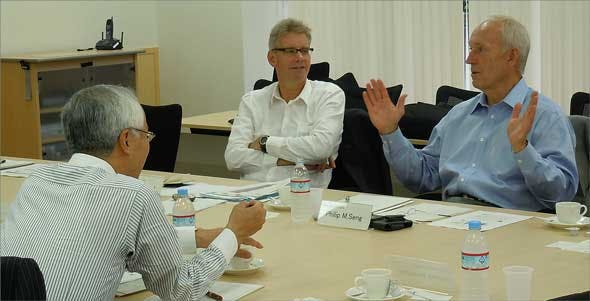USMEF Briefed on Japan Livestock Sector and Quake Aftermath
Published: Jun 22, 2011
USMEF staff led by CEO Philip Seng met this week with officials and analysts from Japan’s Agriculture & Livestock Industries Corporation (ALIC), who shared updated information on the impact of the March 11 earthquake and tsunami on Japan’s regional and national livestock markets.

ALIC President Hiroyuki Kinoshita opened the 26th annual meeting between the two organizations by expressing his gratitude to USMEF for the meal relief efforts sponsored by USMEF’s agriculture industry partners. Both sides agreed to explore ways to enhance communication.
Speaking on behalf of the USMEF delegation, Seng offered condolences to all those affected by the quake, noting that the two countries’ meat and livestock industries share decades of close contact and exchanges. He noted that U.S. industry stakeholders galvanized quickly in response to USMEF’s appeal for assistance to help the people of Japan.
ALIC researchers explained that the weakened Japanese economy was causing a drift downwards in average household food expenditures, and that the foodservice sector was challenged by consumers’ propensity to eat at home.
An analysis of longer-term meat consumption trends shows pork and chicken intake is showing slight signs of growth while beef intake is stable, according to pre-quake ALIC supermarket surveys.
Domestically, a cyclical production increase, coupled with decline in foodservice receipts, has created a pronounced and steady five-year decline in wholesale prices of premium (A-5) Wagyu steers. Japanese beef retail prices also show a decline since a peak in the spring of 2008. ALIC conducts survey research with major retailers and found that prior to the quake, retailer expectations were more bullish toward the marketing potential of domestic and imported pork. Interest in imported pork has been fueled by lingering aftereffects of the April 2010 foot-and-mouth disease (FMD) outbreak in Miyazaki, plus forecasts that domestic pork production will decline.
As to the impact of the quake on Japan’s livestock market, ALIC estimates total quake losses to Tohoku-area agriculture and related industries at $25 billion. While the number of culled livestock (3,500 cattle and 30,000 hogs) in the restricted entry zone near Fukushima was small relative to national inventories, livestock from the wider "evacuation" zone are being subjected to radiation checks as they are moved out of the area for marketing.
Daily radiation tests conducted by the Ministry of Health, Labor and Welfare on all agricultural products have found no contamination in meat samples from the area. Livestock production and marketing throughout the Tohoku region have stabilized, according to ALIC. The quake and tsunami wreaked havoc on coastal feed processing zones in the area. Tohoku is a major poultry producing area with flocks accounting for 23 percent of national inventories. Beef and pork herds in the area represent approximately 12 to 13 percent of national inventories. ALIC claims that disruption to national red meat production has been minimal despite widespread devastation.
Japanese officials are attempting to convince trading partners of the safety of Japan’s agricultural exports from the region, but some markets are imposing restrictions on imports of products from affected prefectures.
USMEF continues its relief efforts in the quake-affected areas this week, with Seng visiting the Tohoku region with USMEF-Tokyo staff to help provide hot meals with U.S. beef and pork to displaced families.
Speaking on behalf of the USMEF delegation, Seng offered condolences to all those affected by the quake, noting that the two countries’ meat and livestock industries share decades of close contact and exchanges. He noted that U.S. industry stakeholders galvanized quickly in response to USMEF’s appeal for assistance to help the people of Japan.
ALIC researchers explained that the weakened Japanese economy was causing a drift downwards in average household food expenditures, and that the foodservice sector was challenged by consumers’ propensity to eat at home.
An analysis of longer-term meat consumption trends shows pork and chicken intake is showing slight signs of growth while beef intake is stable, according to pre-quake ALIC supermarket surveys.
Domestically, a cyclical production increase, coupled with decline in foodservice receipts, has created a pronounced and steady five-year decline in wholesale prices of premium (A-5) Wagyu steers. Japanese beef retail prices also show a decline since a peak in the spring of 2008. ALIC conducts survey research with major retailers and found that prior to the quake, retailer expectations were more bullish toward the marketing potential of domestic and imported pork. Interest in imported pork has been fueled by lingering aftereffects of the April 2010 foot-and-mouth disease (FMD) outbreak in Miyazaki, plus forecasts that domestic pork production will decline.
As to the impact of the quake on Japan’s livestock market, ALIC estimates total quake losses to Tohoku-area agriculture and related industries at $25 billion. While the number of culled livestock (3,500 cattle and 30,000 hogs) in the restricted entry zone near Fukushima was small relative to national inventories, livestock from the wider "evacuation" zone are being subjected to radiation checks as they are moved out of the area for marketing.
Daily radiation tests conducted by the Ministry of Health, Labor and Welfare on all agricultural products have found no contamination in meat samples from the area. Livestock production and marketing throughout the Tohoku region have stabilized, according to ALIC. The quake and tsunami wreaked havoc on coastal feed processing zones in the area. Tohoku is a major poultry producing area with flocks accounting for 23 percent of national inventories. Beef and pork herds in the area represent approximately 12 to 13 percent of national inventories. ALIC claims that disruption to national red meat production has been minimal despite widespread devastation.
Japanese officials are attempting to convince trading partners of the safety of Japan’s agricultural exports from the region, but some markets are imposing restrictions on imports of products from affected prefectures.
USMEF continues its relief efforts in the quake-affected areas this week, with Seng visiting the Tohoku region with USMEF-Tokyo staff to help provide hot meals with U.S. beef and pork to displaced families.
